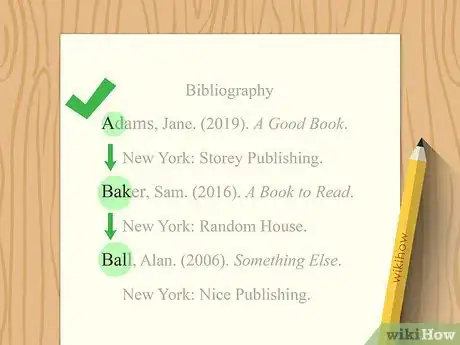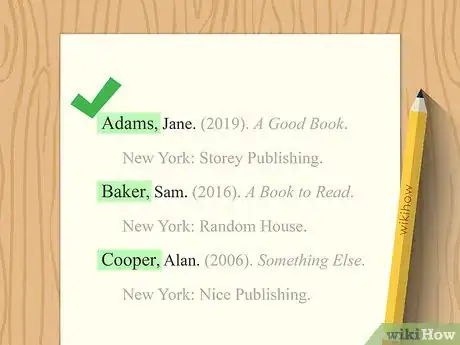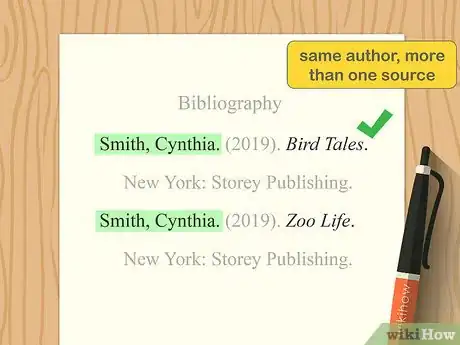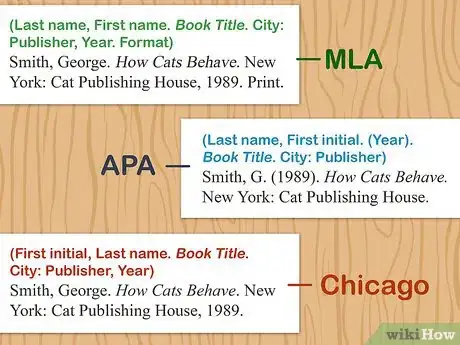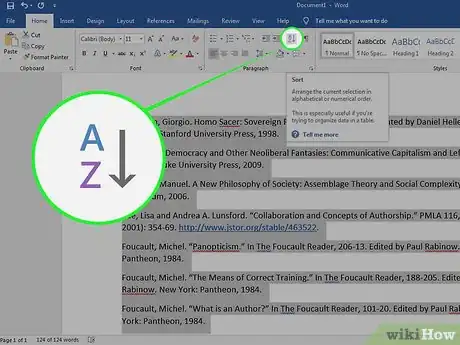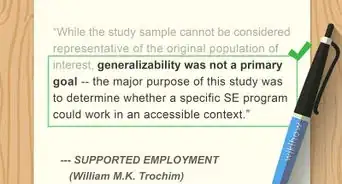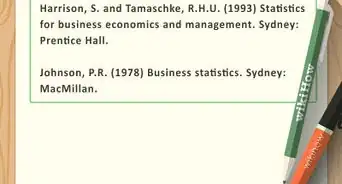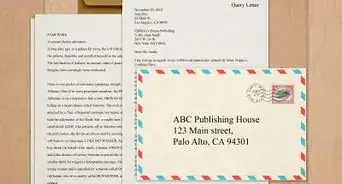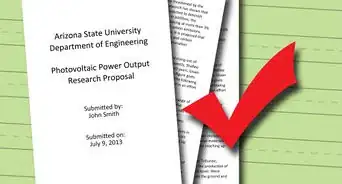This article was co-authored by Michelle Golden, PhD. Michelle Golden is an English teacher in Athens, Georgia. She received her MA in Language Arts Teacher Education in 2008 and received her PhD in English from Georgia State University in 2015.
There are 13 references cited in this article, which can be found at the bottom of the page.
This article has been viewed 54,003 times.
Alphabetizing a bibliography may sound complicated, but it's really not. First, though, you must understand the basics of alphabetizing. Even you think you know how to alphabetize, you may find yourself wondering what to do when you run into a hyphenated word, for instance. You also need to know some of the basic rules of citations, so you know what to use to alphabetize the list. Finally, you can put your list in order.
Steps
Using the Basics of Alphabetization
-
1Go letter by letter. The first letter indicates where it goes generally in your bibliography. For instance, in "Smith," "S" tells you it goes with the "S"s. Once you get to the "S"s, though, you need to know where "Smith" goes among the other "S"s, so you move on to the next letter, "M." You continue going letter-by-letter until you figure out where it fits in with the other entries.[1]
- For example, say you have "Sheldon," "Smith," and "Sherry" as last names you need to alphabetize. "Sheldon" and "Sherry" both have the same first three letters, so you keep going until they are different. The fourth letters in each name are "L" and "R," respectively. Since "L" comes before "R" in the alphabet, "Sheldon" comes before "Sherry" in your bibliography. Therefore, these names would be alphabetized in order in this way: Sheldon, Sherry, Smith.
- "Smith" comes last because the second letter in "Smith," "M," comes after "H" in the alphabet, which is the second letter in both "Sheldon" and "Sherry."
-
2Look at the author’s first name or title. If you have two or more works by two authors with the same last name, then you would use their first names to alphabetize your list of entries. If you have two or more works by the same author, then you would use the title of the work to alphabetize.[2]
- For example, if one author’s name is Robert Smith and the other is Cynthia Smith, then the entry for Cynthia Smith’s work would come first.
- If you have two books or other sources written by Cynthia Smith, then you would look at the titles of these works. For example, if one of the works is called Bird Tales and the other is called Zoo Life, then “Bird Tales” would come first in the list and “Zoo Life” would come second.
Advertisement -
3Treat hyphenated names as one name. In other words, use the first letter of the hyphenated name to alphabetize the name. Therefore, if you have the name "Sheldon-Meyers," the name would be alphabetized under "Sheldon."[3]
- If you have a "Sheldon" and a "Sheldon-Meyers," the shorter name always comes first, so "Sheldon" would come before "Sheldon-Meyers."
-
4Skip punctuation and spaces. When alphabetizing, you don't pay attention to things like accent marks, spaces, or capitalization. You just continue going letter-by-letter to alphabetize.[4]
- As an example, if you have the name "Mc Murry," you essentially treat it as "Mcmurry" for alphabetizing purposes.
-
5Ignore unimportant words. Sometimes, you will be alphabetizing by title. When that's the case, you skip unimportant words at the beginning. The main unimportant words are articles, such as "the," "an," or "a."[5]
- In other words, if the title is "The Cat Who Couldn't Sleep," you would file it under "Cat." One of the reasons for this rule is that so many titles begin with articles that if they were alphabetized under those words, those sections would have too many titles to be useful for finding it later.
Applying the Basics of Bibliographical Alphabetization
-
1Use the author's last name to alphabetize. In most style guidelines, the main way to alphabetize is to use the author's last name. If your book has more than one author, use the author whose name is listed first to alphabetize, though you will list all of the names in the citation.[6]
- For instance, most citations begin with the author's last name, followed by the author's first name or initial, like this: Smith, Josie.
- Therefore, you use "Smith" to place this citation in its proper place in the bibliography.
- If your book had two authors, it would be cited as "Smith, Josie, and Roberta George." Therefore, it would still be alphabetized under "Smith," unless Roberta George was listed first in the book. Use the title page as your guide.[7]
-
2Alphabetize the editor's name on anthologies. Certain works, such as anthologies, will have editors as the main attribution in place of author. In other words, the editor or editors put together a work by many authors, so when you're listing the complete work, you use the editor's name or editors' names in place of an author's name.
- For instance, if the editor's name was Jess Jacob, you would alphabetize the entry under Jacob, Jess.
-
3Look at the title if the book has no author. Sometimes, a resource will not have a named author. If that's the case, you use the title of the resource to alphabetize the book in place of the author's last name.[8]
- For instance, if the title of the resource is "Cats and Their Sleeping Habits," you would file it under "Cats."
-
4List works by the same author according to style guidelines. Sometimes you may end up with more than one work by the same author. If this happens, then you will need to list each work in a separate entry, but the way you go about doing this depends on the documentation style that you are using for the assignment. If you are not sure which style your instructor prefers, then make sure that you ask.[9]
- APA style. Create a normal APA style bibliography entry for each of the works, but place them in the order that they were published. For example, if one work was published in 1993 and another in 1997, then the 1993 work would come first.
- MLA style. Start with a normal works cited page entry for the author’s work that comes first in the alphabet. For example, Pride and Prejudice would come before Sense and Sensibility in a list of works by Jane Austen. Then, start a new entry right after this entry, but begin it with two hyphens instead of listing the author’s last and first name again.
Alphabetizing the Bibliography
-
1Get your citations in order. Before you can alphabetize, you need to make sure you have your citations correct. To know exactly how to do a citation, you need to know what style guidelines your teacher or school requires. Some of the main styles are the Modern Language Association (MLA) style, the American Psychology Association (APA) style, and the Chicago Manual style.
- For instance, a basic citation in MLA will look something like this one: Smith, George. How Cats Behave. New York: Cat Publishing House, 1989. Print.[10]
- In this instance, the author's name is George Smith. "How Cats Behave" is the title. "New York" is the city it was published in, and "Cat Publishing House" is the publisher, while "1989" is the year it was published. "Print" is the format it was published in.
- In Chicago Style, this citation would look this way in the bibliography: Smith, George. How Cats Behave. New York: Cat Publishing House, 1989. The basic style is fairly similar to MLA in the bibliography.[11]
- The same citation would look like this in APA: Smith, G. (1989). How Cats Behave. New York: Cat Publishing House. Notice that this citation only uses the first initial of the author's name and moves the publication date closer to the beginning.[12]
-
2Alphabetize manually. The easiest way to alphabetize manually is to start with the "A"s. Find all the citations that start with an "A," and pull them to the top. Sort them out so that they are alphabetical, then move on to the "B"s. Keep going until you've sorted all your citations.
-
3Remember that you'll be alphabetizing citations that begin with author's names and titles all together. Your first citation, for example, could start with the title "Aardvark Studies." This could be followed by a citation that starts with an author's name, like "Abraham, Lindsay."
- Apply the alphabetizing rules as you go.[13]
-
4Sort with the word processing software. Another way to alphabetize is to let your word processing software do the work. Put your citations in as separate paragraphs, meaning you just have a line between each citation. Highlight the text. In Microsoft Office, click on the button under the "Home" ribbon that says "AZ" with a little arrow.[14]
- You might also need to look under the "Table" menu to find the sort button. It will ask you how you want them sorted. Choose by paragraph and text in ascending order.
- The list will be sorted alphabetically, but you will need to format the citations with proper indentations and such still.
-
5Use a bibliography generator. A final option is to use a bibliography generator. You put all the information for your citations into a generator. It makes sure the citations are correct in the style you need, then it spits out an alphabetized list ready for you to use.[15]
- However, it's important to check your citations when it's done, as these systems are not perfect.
Community Q&A
-
QuestionHow do I include a Bible verse in the bibliography?
 Community AnswerFollow the reference style required and include the book of the Bible (e.g. Matthew), the chapter and verse (e.g. 5:3-12), Holy Bible, followed by version (e.g. King James Version).
Community AnswerFollow the reference style required and include the book of the Bible (e.g. Matthew), the chapter and verse (e.g. 5:3-12), Holy Bible, followed by version (e.g. King James Version). -
QuestionHow do I alphabetize a name that has a symbol in it?
 Community AnswerIgnore the symbol. Treat the name alphabetically by the alphabetical letters in the name, unless the symbol is a hyphen (-). Hyphens should be included, as they link the parts of the name. You will find that this is not followed in the same way by all publications. The best practice is to follow the referencing style guide if it covers this aspect.
Community AnswerIgnore the symbol. Treat the name alphabetically by the alphabetical letters in the name, unless the symbol is a hyphen (-). Hyphens should be included, as they link the parts of the name. You will find that this is not followed in the same way by all publications. The best practice is to follow the referencing style guide if it covers this aspect. -
QuestionIf the author begins with @, where do I put it?
 Community AnswerUse the author's name. @ is an pointer, not a name. If you are referring to a tweet or other online message, use the first letter of the author's 'name' in the alphabetical list and exclude the @.
Community AnswerUse the author's name. @ is an pointer, not a name. If you are referring to a tweet or other online message, use the first letter of the author's 'name' in the alphabetical list and exclude the @.
References
- ↑ https://liu.cwp.libguides.com/c.php?g=45846&p=291626
- ↑ http://www.sussex.ac.uk/informatics/punctuation/essaysandletters/bibliography
- ↑ http://www.chicagomanualofstyle.org/qanda/data/faq/topics/Alphabetizing.html?page=1
- ↑ https://morningside.libguides.com/APA7/references
- ↑ https://apastyle.apa.org/blog/alphabetize-nonsignificant-words
- ↑ https://owl.purdue.edu/owl/research_and_citation/asa_style/references_page_formatting.html
- ↑ http://www.bibme.org/citation-guide/mla/book
- ↑ https://columbiacollege-ca.libguides.com/c.php?g=725852&p=5228058
- ↑ https://liu.cwp.libguides.com/c.php?g=45846&p=291626
- ↑ https://libguides.unf.edu/citationguide/samplemla
- ↑ https://www.chicagomanualofstyle.org/tools_citationguide/citation-guide-1.html
- ↑ https://libguides.unf.edu/citationguide/apasample
- ↑ http://www.chicagomanualofstyle.org/qanda/data/faq/topics/Alphabetizing.html?page=1
- ↑ https://support.microsoft.com/en-gb/office/sort-a-list-alphabetically-in-word-4d27ca57-6d64-4229-82f8-a0a1a805d494
- ↑ http://www.easybib.com/
